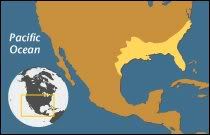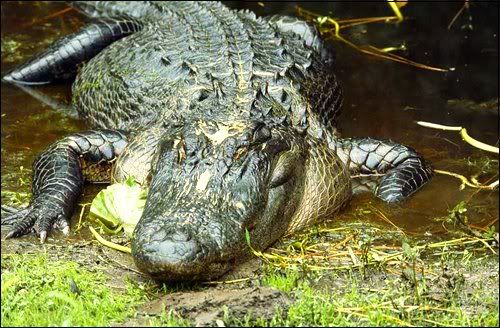|
|
Post by Revenge on Apr 14, 2009 10:17:00 GMT -5
Alligators
A Living Fossil: A throwback to the time of dinosaurs, the alligator and its relative the crocodile have changed little in the last 65 million years. The Chinese alligator of Eastern Asia and the American alligator of the southeastern United States are the only two species to have survived evolution
Death from Below: Both species prefer freshwater lakes, marshes and swamps, where they are commonly seen floating in a partially submerged, death-like stasis at the water's surface in anticipation of a fresh meal. They eat a variety of small prey, such as fish, turtles, snakes and small rodents, which they snap up and devour whole. Larger prey, like fully grown wild boars or even antelope, are dragged below the water's surface and held in a viselike grip until they drown, then are devoured piece by piece.
Mating and Rearing: Mating takes place underwater and males attract females by a roaring call. Twenty-five to 60 eggs can be laid by one female each season, which are placed in an enormous nest constructed of vegetation and mud. The mother will stay with the young for as long as three years.
American Comeback: The most widely studied alligator is probably the American alligator. Once seriously endangered in the 1950s due to the fashionable coveting its skin, the American alligator has staged a comeback after being placed under legal protection.
Croc or Gator?: Alligators may look indistinguishable from crocodiles at first glance, but there are several differences. For instance, alligators have broad, U-shaped snouts whereas crocodiles have narrower, V-shaped snouts.
DID YOUR KNOW?
An Unbeatable Bite: At nearly 3,000 pounds per square inch, the American alligator has the most powerful bite ever measured in the animal kingdom.
Holing Up for Winter: In winter, many alligators undergo a period of dormancy. They enter an underground burrow or den and wait for the arrival of spring.
Giant Lizard?: The word "alligator" comes from the Spanish "el lagarto," which means "the lizard." Spanish sailors thought alligators were giant lizards when they first arrived in the Americas. |
|
|
|
Post by Revenge on Apr 14, 2009 10:25:43 GMT -5
The American Alligator
American Alligator Profile
The American alligator is a rare success story of an endangered animal not only saved from extinction but now thriving. State and federal protections, habitat preservation efforts, and reduced demand for alligator products have improved the species' wild population to more than one million and growing today.
One look at these menacing predators—with their armored, lizard-like bodies, muscular tails, and powerful jaws—and it is obvious they are envoys from the distant past. The species, scientists say, is more than 150 million years old, managing to avoid extinction 65 million years ago when their prehistoric contemporaries, the dinosaurs, died off.
American alligators reside nearly exclusively in the freshwater rivers, lakes, swamps, and marshes of the southeastern United States, primarily Florida and Louisiana.
Heavy and ungainly out of water, these reptiles are supremely well adapted swimmers. Males average 10 to 15 feet (3 to 4.6 meters) in length and can weigh 1,000 pounds (453 kg). Females grow to a maximum of about 9.8 feet (3 meters.)
Hatchlings are 6 to 8 inches (15 to 20 centimeters) long with yellow and black stripes. Juveniles, which are on the menu for dozens of predators, including birds, raccoons, bobcats, and even other alligators, usually stay with their mothers for about two years.
Adult alligators are apex predators critical to the biodiversity of their habitat. They feed mainly on fish, turtles, snakes, and small mammals. However, they are opportunists, and a hungry gator will eat just about anything, including carrion, pets and, in rare instances, humans.
American Alligator Range (In the yellow)
Fast Facts
Type: Reptile
Diet: Carnivore
Average lifespan in the wild: 35 to 50 years
Size: 10 to 15 ft (3 to 4.6 m)
Weight: 1,000 lbs (453 kg)
Group name: Congregation
Did you know?: The largest American alligator ever reported was supposedly 19.8 feet (6 meters) long, although there are doubts about the claim.
Protection status: Recovered
Size relative to a 6-ft (2-m) man
|
|
|
|
Post by Revenge on Apr 14, 2009 11:12:59 GMT -5
|
|





